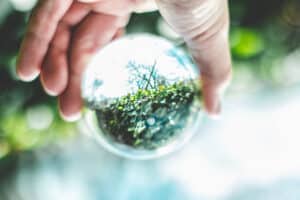There is increasing talk of scarcity of resources and the circular economy. Although the Western concept of circular economy appeared in the 1980s, it is only in the last decade that it has really gained momentum, as it is considered one of the best ways to curb environmental degradation and, consequently, slow down climate change. The ultimate goal is to improve the sustainability of life on Earth.
What is the circular economy?
A model of production and consumption that involves sharing, renting, reusing, repairing, renewing and recycling existing materials and products as often as possible to create added value (source: European Parliament). The Circular Economy includes not only the 3Rs Rule (Reduce, Reuse, Recycle), but also a series of principles that support the Circular Economy:
- Considering the planet as the sole supplier of resources. Rational management in the flow of these resources will allow their conservation and optimization.
- Stimulation and encouragement of product repairs.
- Discouraging the culture of possession in favor of enjoyment based on the use of a product or service. This material uprooting would lead to an automatic decrease in the demand for manufactured products, with all the positive impact it would have on the exploitation of natural resources.
- Considering the environmental impact and consequences of the production of goods as the main part of the process and not an appendage.
- Limiting the generation of waste and reusing it as much as possible, which is undoubtedly a major commitment to recycling. In addition, it will become a priority to try to find a useful exploitation for waste that cannot be reused, by putting it into the energy chain. In this respect, the New Law on Waste is key, as we mentioned in a previous article.
- “Reinvention” of certain goods and products for tasks other than those planned in their initial design.
Stages of the Circular Economy Model
The Circular Economy model goes through the following stages: collection of raw materials, design, production-remanufacturing, distribution, consumption – use – reuse – repair and collection and recycling. All of them without forgetting the inevitable generation of residual waste that the production process entails.
- Raw materials: beginning of the development of the production-consumption chain. An efficient and sustainable choice of natural resources is fundamental.
- Design: the efficient use of raw materials from the previous stage will depend to a large extent on design. Design influences the final shape of the product, but also its useful life and possible subsequent reuse.
- Production-remanufacturing: maximizing the resources available for manufacturing (the type of energy used, the mode of manufacture, the location of the factory…).
- Distribution: the means of transport chosen (with the consequent fuel and environmental impact).
- Consumption-use-reuse-repair: responsible use is essential in managing the scarcity of natural resources. Extending the useful life of products through continued use or repair.
- Residual waste: the challenge is to find a use for waste in order to give it a new life and extend the life cycle of the circular model as much as possible, while at the same time managing to remove or reduce the amount of final waste and its consequent environmental impact.
- Collection and recycling: waste collection and recycling are key to the production cycle. Apart from the actions of companies (which are really what will make the difference), the behavior of individual consumers will also be decisive.
Barriers to the Circular Economy
The reasons why it is being difficult to implement the Circular Economy are diverse, although perhaps the biggest of all is the lack of a sustainable mentality among consumers and companies themselves, who are more accustomed to the traditional linear economic model, based on what today is beginning to be considered as utter nonsense: the maxim of “use and throw away”. Other barriers holding back the Circular Economy are:
- Lack of regulations and policies: everything related to eco-design, consumption and reuse has very few policies and regulations, and these do not go beyond information or awareness campaigns.
- Lack of adequate technological mechanisms: both technical skills of specialists and technological elements are necessary.
All barriers are interrelated and it is the authorities who must consider the real change to an economic model that can only bring benefits. To do this, they will have to work on effective policies, on raising awareness among the population and companies, and on investment that will make a brighter future possible.
A New Proposal: Spiral Economy
The life of products, their reuse and their components are limited, so their degree of utilization depreciates with use.
A pure circular model would imply infinite incorporation of resources into the production and consumption chain, which is impossible. This depreciation, together with the “definitive” waste generated by the system, makes the model closer to a spiral format (Jiménez Herrero: “Circular-spiral economy: transition towards a closed economic metabolism”).
This last consideration helps to avoid the misconception that the circular economy is a definitive solution. It is indeed an extension of the use of products and resources, with all that this implies; but in no case should we ignore its outdated nature in terms of the cycle of exploitation. To be aware that the model is approaching this spiral is to understand that it is not a definitive solution (the final balance) but that it requires involvement, commitment and long-term monitoring and optimization of all the indicators that will make it possible to achieve the objectives.
Evlox for the Circular Economy
At Evlox we are committed to the promotion of the Circular Economy, which we have been part of for years, working on aspects such as the commitment to recycling, sustainable fabrics (such as hemp or linen), regenerative cotton and, ultimately, an ethical and sustainable fashion that contributes to circularity and care for the environment.
To learn more about our sustainability policies, visit our website.
